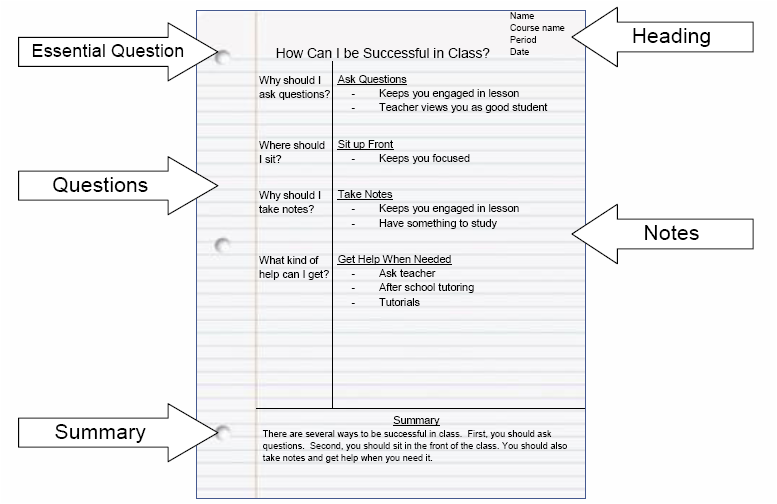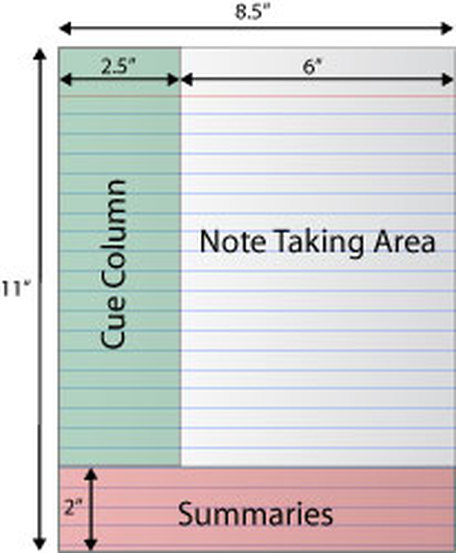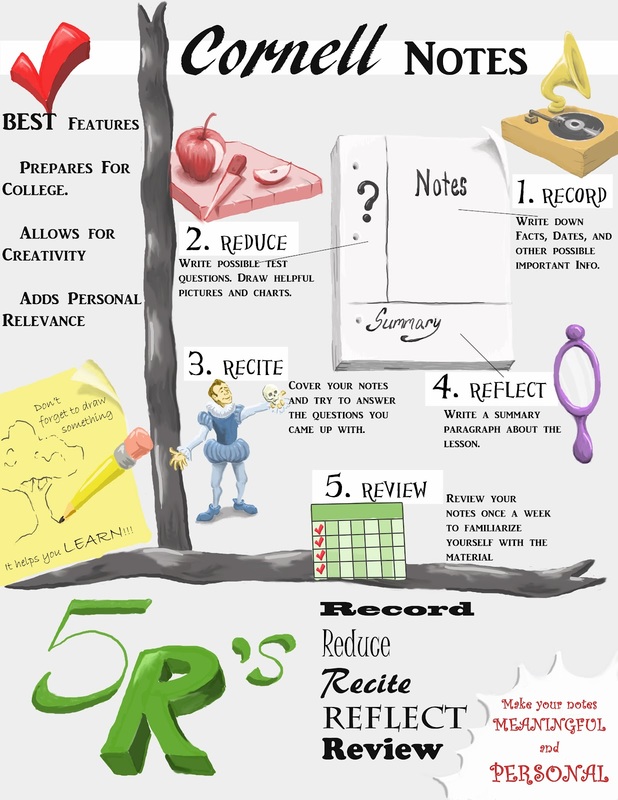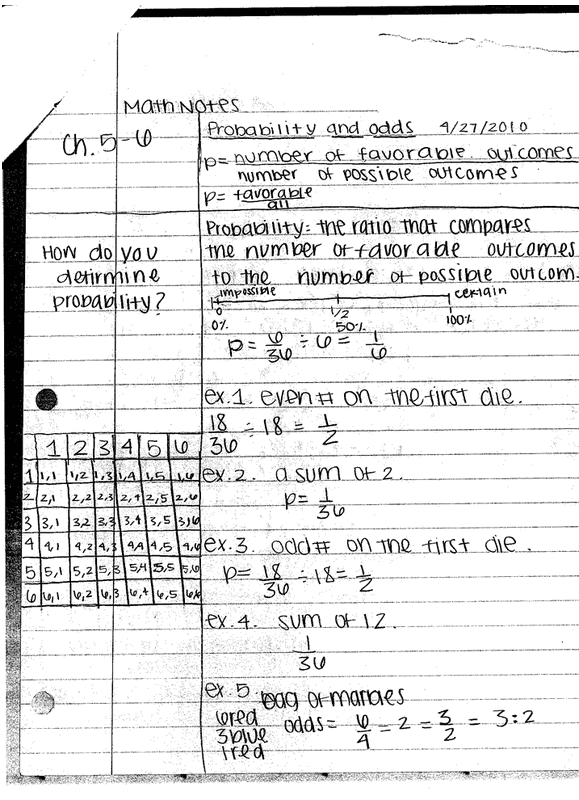Cornell Notes
Students who have learned and practiced Cornell Notes as a strategy have increased their engagement and comprehension of concepts in the text. This type of skill is referred to as note making as opposed to note taking. Note making must be taught explicitly to learn which details are important notes to record. Teacher teaches the strategy through modeling, guided practice, and independent practice. These notes can then be used as a resource before a test (Miller & Veatch, 2011, p. 80).
During the 1940s Walter Pauk, a professor from Cornell University was the first to introduce Cornell Notes. Cornell Notes can be used with expository text, as well as, detail-rich text, but can be used across content areas (Miller & Veatch, 2011, p. 80). This strategy is used like a graphic organizer in your notebook, where the student creates three sections, similar to the diagram below:
This method is similar to a graphic organizer where students pick out the main ideas and supporting details, but the idea is that they add their thoughts, questions, and ideas into the notes to aid in creating an effective review (Engaging Minds Online, 2015). After class, students will need to find a time to summarize their notes, giving them another opportunity to review and understand them one step further.
When using Cornell Notes to review, students need to fold their notes between the two columns and are able to read the questions or headings to remind them about the notes they took that relates to that question or heading (Engaging Minds Online, 2015). Procedure
Tied to Writing
Cornell Notes involve the student writing subheadings from the text, along with supporting details to create a graphic organizer in the students notebooks. This allows students the flexibility and format of their notes, but later works as a great study tool. Cornell Notes also offer students an opportunity to comprehend the text and put into words what it means through the use of a summary.
CCSS.ELA-Literacy.W.6.2.a
Introduce a topic; organize ideas, concepts, and information, using strategies such as definition, classification, comparison/contrast, and cause/effect; include formatting (e.g., headings), graphics (e.g., charts, tables), and multimedia when useful to aiding comprehension. CCSS.ELA-Literacy.W.6.2.f Provide a concluding statement or section that follows from the information or explanation presented. Range of Writing:CCSS.ELA-Literacy.W.6.10 Write routinely over extended time frames (time for research, reflection, and revision) and shorter time frames (a single sitting or a day or two) for a range of discipline-specific tasks, purposes, and audiences (Common Core State Standards Initiative, 2015). |
Kimberly Carey
Course: EEC 428 Professor: Dr. Lori Piowloski Minnesota State University, Mankato How to Take COrnell Notes in a math class
(Hill, 2014)
This teacher does a very good job explaining the step by step process of how to complete the Cornell Notes. He covers Cornell Math Notes specifically. I am a math teacher and I am always trying to relate anything I do back to math, so it was great to see the variations and how different the notes will appear in a math class, opposed to any other subject area class.
Cornell Note-Taking
(CSUTASC, 2011)
This video shows how easily our traditional notes can be converted over to the Cornell Note-taking Method. The information is presented in a way that is easy to follow, humorous, and informational. This would make for a great review video because it highlights on the main parts needed for your notes.
Additional Resources
| ||||||
References
AVID. (n.d.). Cornell notes. Retrieved from http://erhsavid.weebly.com/cornell-notes.html
Bretz, P. (2010, March 1). Cornell note taking examples-math. Retrieved from http://enlighteninglearnersweblog.com/blogs/blog2.php?title=cornell-note-taking-examples-math&more=1&c=1&tb=1&pb=1
Common Core State Standards Initiative. (2015). English Language Arts Standards. Retrieved from http://www.corestandards.org/ELA-Literacy/W/6/
CSUTASC. (2011, October 3). Cornell note-taking [Video file]. Retrieved from https://www.youtube.com/watch?v=tdTyy1b3mGQ
Engaging Minds Online. (2015, March 6). The many functions of graphic organizers [Video file]. Retrieved from http://www.engagingmindsonline.com/blog/26-blog/264-use-graphic-organizers-for-note-taking-too
Hill, M. (2014, August 19). How to take cornell notes in a math class [Video file]. Retrieved from https://www.youtube.com/watch?v=tIUf_ghDE1U
Jannucci. (2015, June 14). [Graphic]. Retrieved from http://www.jannucci.com/index.php?p=1_28
Miller, M., & Veatch, N. (2011). Literacy in context (linc): choosing instructional strategies to teach reading in content areas for students grades 5-12. Boston: Pearson.
Bretz, P. (2010, March 1). Cornell note taking examples-math. Retrieved from http://enlighteninglearnersweblog.com/blogs/blog2.php?title=cornell-note-taking-examples-math&more=1&c=1&tb=1&pb=1
Common Core State Standards Initiative. (2015). English Language Arts Standards. Retrieved from http://www.corestandards.org/ELA-Literacy/W/6/
CSUTASC. (2011, October 3). Cornell note-taking [Video file]. Retrieved from https://www.youtube.com/watch?v=tdTyy1b3mGQ
Engaging Minds Online. (2015, March 6). The many functions of graphic organizers [Video file]. Retrieved from http://www.engagingmindsonline.com/blog/26-blog/264-use-graphic-organizers-for-note-taking-too
Hill, M. (2014, August 19). How to take cornell notes in a math class [Video file]. Retrieved from https://www.youtube.com/watch?v=tIUf_ghDE1U
Jannucci. (2015, June 14). [Graphic]. Retrieved from http://www.jannucci.com/index.php?p=1_28
Miller, M., & Veatch, N. (2011). Literacy in context (linc): choosing instructional strategies to teach reading in content areas for students grades 5-12. Boston: Pearson.




